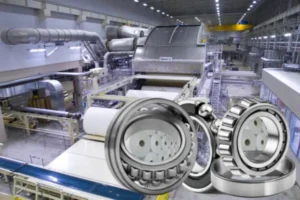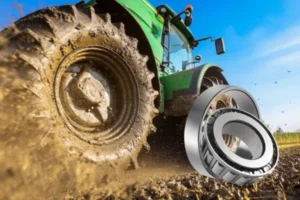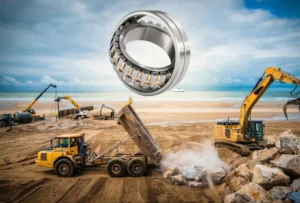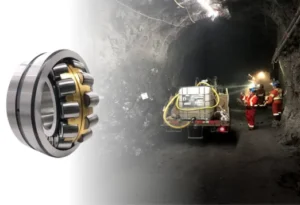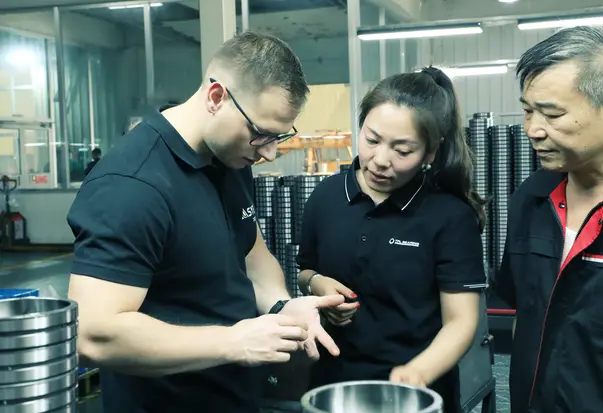Modern assembly lines can lose a lot of money if they stop working without warning. The car industry alone can lose up to $557 billion each year.
Bearings are very important in these places. Roller bearings, track rollers, and yoke rollers fight against wearing out. They spread out the weight and help things move in a straight line on the guide. Picking and putting in the right linear bearing lowers friction. This makes the linear guide work better and stops expensive breaks. These parts help machines last longer and keep working well.
Key Takeaways
- Track roller bearings help machines move with less friction. They can carry heavy things. This makes machines last longer. It also means they break down less often.
- Steel track rollers do not wear out fast. They do not rust easily. This makes them good for hard jobs. They also need less fixing.
- Picking the right bearings and rollers helps machines stay straight. It makes them move smoothly. It also helps them last longer.
- Choosing good bearings and doing regular checks saves money on repairs. It helps teams plan better. This way, there are fewer surprises.
- Good teamwork between engineers and suppliers is important. It helps pick the best bearings. This means fewer breakdowns and more work gets done.
Challenges with Previous Bearings
Industry type (e.g., automotive, packaging, electronics)

This assembly line works in the automotive industry. The industry needs to make many cars quickly. Machines must work well for a long time. Many parts move, like conveyors and robotic arms. These parts use linear motion systems. Bearings are very important for these systems. In car factories, there is a lot of dust, metal bits, and grease. These tough conditions make old bearings wear out faster.
Downtime Issues
Unplanned stops often happen on car assembly lines. Bearing problems are a big reason for these stops. The main causes of bearing downtime are:
| Cause of Bearing-Related Downtime | Explanation / Contributing Factors | Preventive Measures |
|---|---|---|
| Wear and Tear | Bearings and other parts get worse over time from use | Regular checks, oiling, and maintenance |
| Dirty Tooling and Feeders | Dust and dirt build up and hurt bearing work | Cleaning and maintenance plans |
| Lack of Lubrication | Not enough oil makes friction and causes failure | Set times for oiling bearings |
| Operator Errors | Wrong use or care can break bearings early | Training workers and checking their work |
Even short stops from bearing trouble make machines less available. This lowers how much the line can make. If one part breaks, the whole line can stop. This can delay deliveries and cost more money.
Maintenance Problems
Old bearings in linear guides had many problems:
- Dirt, dust, and metal bits made them wear out and broke seals.
- Putting them in wrong caused dents and early damage.
- If not lined up right, they got hot and broke inside.
- Shaking made it hard to keep them oiled and wore them out faster.
- Not enough oil, because of rare checks, made them too hot.
- Wetness and big temperature changes made them last less time.
- Water or acid caused rust and more damage.
- Hard-to-reach bearings broke more because people missed checks.
Note: Machine failures, like bearing problems, cause most surprise stops in factories. Old bearings can stop conveyor motors for hours. This messes up plans and costs more. Fixing things only when they break, instead of checking often, makes these problems worse and makes machines not last as long.
Good roller bearings and better linear bearing designs help fix these problems. They lower friction, last longer, and help machines work better in hard places.
Evaluation & Selection Process
Assessment of possible bearing and roller solutions
Engineers had many choices for bearings on the assembly line. They wanted to make movement better and stop downtime. The bearings also needed to hold heavy loads. The team looked at different types of bearings and rollers. Each one had good and bad points for the job.
They checked some important things when picking bearings:
- Load capacity: The team made sure the bearing could take heavy loads. They checked if it could handle both radial and axial loads. They also thought about shock loads from fast moves.
- Speed: They looked at how fast the guideways would move. The bearing had to keep up without getting too hot.
- Environmental conditions: The assembly line had dust, grease, and changing temperatures. The bearings needed to work well in these tough places.
- Alignment and misalignment: Some parts could shift or bend a little. Bearings had to allow for small misalignments and still work right.
- Space constraints: The engineers measured the space they had. Some spots were tight and needed small bearings.
- Precision requirements: The line needed high precision for smooth movement and control.
- Lubrication and maintenance: The team wanted bearings that were easy to care for. They also wanted them to hold oil for a long time.
They compared different bearing types:
- Spherical roller bearings: These can take heavy radial loads and some axial loads. They can self-align, which helps with misalignment.
- Cylindrical roller bearings: These are good for high radial loads and fast speeds. They give good precision and accuracy.
- Angular contact ball bearings: These handle both radial and axial loads. They are best for high speed and high precision.
- Vibratory bearings: These are made for heavy loads and tough places.
- Radial insert ball bearings: These can handle some misalignment and are easy to put in.
- Needle roller bearings: These fit in small spaces and carry high loads with low friction.
The team also looked at plain linear bearings. But rolling bearings worked better for what they needed.
Why track roller bearings, steel track rollers, and yoke rollers were considered
The engineers picked track roller bearings, steel track rollers, and yoke rollers. These parts gave the best mix of strength, efficiency, and control for the line.
Track roller bearings were special because they lower friction and help the guideways work better. Roller bearings have a bigger contact area than ball bearings. This helps them carry heavier loads and take shocks better. They also handle both radial and axial loads. This is important for the assembly line’s complex moves.
Steel track rollers were stiff and did not bend much. This kept the guideways straight and accurate, even with heavy loads. Steel also made the track last longer. It helped stop wear on both the bearing and the guide. Steel track rollers could also deal with dirt better, especially with good oil and covers.
Yoke rollers were good for tight spaces and could take side loads. The team picked yoke type track rollers with special shapes. These rollers were stiffer and bent less, which made the guideways more accurate. The special shape also lowered Hertzian pressure. This meant less stress and less damage to the guide.
Here is a table that compares yoke type track rollers:
| Aspect | Yoke Type Track Rollers (Optimized Profile) | Notes / Additional Information |
|---|---|---|
| Stiffness (Radial Deflection) | Higher stiffness, lower deflection | Better rigidity in outer ring contact |
| Wear of Mating Track | Reduced wear | Longer rating life of guide |
| Hertzian Pressure | Lower maximum pressure | Less stress, less damage |
| Friction Coefficient | 0.002 to 0.003 | Friction rises with axial loads |
| Damping | Not specified | |
| Impurity Management | Implied importance of cleanliness | Lubrication and covers help |
The team also thought about how to put in and take out the bearings. They followed careful steps to stop damage and dirt. They picked strong materials for the guide and rollers. They used hardened steel for both the rollers and the guide tracks. This made the parts last longer and work smoothly.
Lubrication was very important in their choice. The team picked bearings that could keep oil inside and were easy to check. They also added covers and wipers to keep out dust and dirt.
The Solution
Installation of track roller bearings in critical joints

Engineers found the most important joints on the linear guideways. These spots had the heaviest loads and moved the most. The team put roller bearings at these places. This lowered friction and made the linear systems more reliable. Roller bearings helped things move smoother and spread out the weight better. Now, the assembly line could handle heavy parts without stopping or wearing out too fast. The new linear guideways also made it easier to keep machines working well.
Upgrade to steel track rollers for durability
The team switched to steel track rollers to make them last longer. Steel track rollers are made from strong steel. They can take heavy loads and work in tough places. They do not rust easily and need less care, so they last longer. Many industries saw real improvements after this change:
- Wind turbine assembly lines made 20% more products after using strong steel rollers.
- Aerospace factories had less damage and needed less hand work with custom steel rollers.
- Recycling plants moved 30% more items after adding heavy-duty rollers.
These results show that steel track rollers make linear guideways stronger and save money over time.
Integration of roller ball transfer bearings at key transfer points
Some spots on the assembly line needed things to move in any direction. The team put roller ball transfer bearings in these places. These units let products move easily in all directions on the linear guideways. Case studies show that spring-loaded ball transfer units help by changing to different loads and heights. For example, a car assembly line worked 15% better after adding these units. The spring part takes in shocks, keeps the load and bearing safe, and cuts down on care. This upgrade made moving things smoother and caused fewer mistakes.
Use of yoke rollers for tighter design constraints and better side-load handling
Some parts of the assembly line were small and needed to handle side loads. Yoke rollers were perfect for these spots. Their special shape and stiffness let them fit in tight spaces on the linear guideways. Yoke rollers also handled side loads better than other choices. This made the linear systems more accurate and last longer. The assembly line could now do harder moves without losing reliability.
By picking the right roller bearings and making each part of the linear guideways better, the team fixed big problems and helped the assembly line succeed for a long time.
Results After Implementation
Measurable decrease in unplanned downtime
After the new roller bearings were put in, the assembly line stopped less often. Workers saw fewer emergency stops and smoother work. The engineering team watched the machines for six months and saw these changes:
| Metric | Measurable Impact |
|---|---|
| Reduction in unplanned failures | 70% |
| Reduction in total maintenance costs | 25% |
| Increase in uptime via predictive maintenance | 70-75% |
| OEE improvement in manufacturing | 5-15% |
| Maintenance cost reduction via PdM | 25-30% |
| Equipment service life extension | 20-40% |
These numbers show the new bearings and guideways made the line work better. Machines ran longer without stopping. One worker said,
“We used to have breakdowns every week. Now, we go weeks without any trouble. The new roller bearings made a huge difference.”
Other factories saw the same thing. For example, some plants that used enclosed bearings stopped losing six hours each week. They also spent 40% less on fixing machines. These results show why better roller bearings and guideways help so much.
Reduced maintenance frequency and costs
Maintenance teams saw they did not need to check the new guideways as much. The roller bearings kept oil inside and blocked dirt. This meant fewer stops and lower repair bills. The team saw these results:
- 35-45% less downtime
- 70-75% fewer breakdowns
- 25-30% lower maintenance costs
A supervisor said,
“We spend less time fixing and more time making sure everything runs right. The bearings last longer, and we do not have to replace them as often.”
Other places, like paper mills, also got good results. Checking bearings often made them last longer and kept workers safe. These results show why buying good roller bearings and guideways is smart for the future.
Improved machine alignment and smooth track performance
The new guideways helped keep machines lined up right. Roller bearings gave better control and made parts move steady. Workers saw less shaking and smoother starts and stops. This helped the line stay accurate and made fewer mistakes.
Predictive maintenance tools helped a lot. Sensors and AI watched for shaking and heat. These tools found problems early. Maintenance teams could fix things before they got worse. One worker said,
“The machines feel smoother, and we can trust the movement every time. The precision is much better now.”
This focus on control made the line more reliable. The better guideways kept everything in place, which is important for jobs that need high accuracy.
Increased equipment lifespan and production efficiency
The upgrades made the machines last longer. The new roller bearings and guideways stopped parts from wearing out fast. Machines ran cooler and quieter. The team saw equipment last 20-40% longer. The line made more products each hour and met delivery goals more often.
Predictive maintenance made things even better. With sensors and AI, the team could plan repairs before things broke. This saved time and money. Companies using these tools saw up to a 12% jump in how well their machines worked.
A manager said,
“We see fewer breakdowns and more output. The new bearings and linear guideways help us hit our goals and keep customers happy.”
These results show why good roller bearings and guideways are important for today’s assembly lines. They help bearings last, make machines more accurate, and keep work moving.
Lessons Learned
Importance of bearing quality in high-throughput systems
Assembly lines that make lots of products need good bearings. Experts say clean parts and careful setup matter a lot. Even tiny dirt or small mistakes can break bearings early. This means more stops and higher bills. Clean bearings last longer and help machines work better. They also make less noise. When engineers use strong materials and special coatings, the system can handle heavy loads and fast speeds. The line keeps moving and helps companies reach their goals.
How proper roller selection impacts maintenance planning
Picking the right rollers changes how teams plan repairs. Some good tips are:
- Powered rollers carry more weight and are quieter than manual ones.
- Rollers need less care than belts or chains, so teams save time.
- Clean rollers stop jams and lower friction.
- Teams should check roller clutches often and swap them if needed.
- How often you check depends on how busy the line is—busy lines need weekly checks, slow lines need fewer.
- Marks on rollers may show problems with the process, not just the roller, so teams must watch both.
The right rollers mean fewer breakdowns and easier repairs. This helps teams plan better and avoid surprises.
The role of suppliers and engineering teams in long-term system health
Suppliers and engineers help keep assembly lines working well. They must avoid common mistakes when changing bearings. The table below shows why these problems happen and how to stop them:
| Common Pitfall | Causes | Risks/Consequences | How to Avoid / Solutions |
|---|---|---|---|
| Insufficient Lubrication | Missed checks or broken seals | Overheating, noise, shorter bearing life | Follow strict schedules, use the right oil, check seals |
| Moisture Contamination | Water or wet air in the system | Rust, damage inside the bearing | Use covers, control temperature, use the right grease |
| Overloaded Bearings | Loads too heavy or wrong setup | Shorter life, more replacements | Follow load limits, pick the right size, check the fit |
| Underloaded Bearings | Loads too light or speeds too high | Skidding, less accuracy, overheating | Match bearing to load and speed, control speed ramp-up |
When suppliers like TFL work with engineers, they help pick the best parts and teach good habits. Working together keeps machines running longer and saves money.
In short, good bearings, smart roller picks, and strong teamwork with suppliers mean fewer stops and lower costs. If you want to make your assembly line better, TFL Bearings can help you find the right answer. I have seen how the right bearing really matters.
- Track roller bearings let smart sensors watch the machines all the time. This helped workers fix problems before things broke. It stopped long stops and saved money on repairs.
- Dashboards showed what was happening right away. Listening tools found problems early, so teams could plan repairs.
- The new system made machines work better and matched Industry 4.0 rules.
If your team wants fewer breakdowns and smoother work, TFL can help. These experts help you pick the best bearings for your assembly line.
FAQ
Why do track roller bearings reduce downtime on assembly lines?
Track roller bearings lower friction and handle heavy loads. This design helps machines run longer without stopping. Workers see fewer breakdowns because the bearings last longer and need less care.
Why should engineers choose steel track rollers for harsh environments?
Steel track rollers resist wear and corrosion. They work well in dirty or wet places. This choice helps machines stay reliable and reduces the need for frequent replacements.
Why does proper bearing selection impact maintenance costs?
Choosing the right bearing prevents early failures. Good bearings need less oil and block dirt better. Maintenance teams spend less time fixing problems and more time keeping the line running.
Why do yoke rollers help in tight spaces?
Yoke rollers fit into small areas and handle side loads well. Their shape gives extra strength. This makes them ideal for compact machine designs.
Why partner with TFL for bearing solutions?
TFL offers expert advice and quality products. Their team helps engineers pick the best bearings for each job. This partnership leads to fewer breakdowns and better machine performance.
